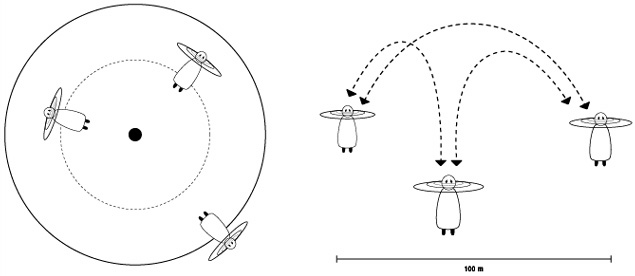|
Medium: Land Art/Network
Project Description:
According to the Environmental Protection Agency, accepted land use varies depending on the level of toxicity in the soil. For example, the toxic levels can be higher on low use properties, i.e. wild land, sewer treatment plants, and golf courses. Land which is inhabited by humans must have lower levels of contaminants in the soil. Based on this environmental law of land use on affected zones, Futurefarmers proposes a game where people can keep a check and balance on the shifting soils of the Great Park.
Ad-hoc ecosystem is a community tool to be distributed among Orange County residents [or any Open Space development]. It a piece of open source software which can be downloaded via the web to computers, pda's and cellphones. Participants collectively monitor the social, political and environmental organization of the Great Park. Residents virtually maintain the equilibrium of the Park ecosystem by taking on roles, actions and resources.
++
Launch Tool
According to a remedial investigation and feasibility study conducted by the Marine Corps,
El Toro, accepted land use varies depanding on levels of soil pollution. Soil pollution can
be higher if there is a low level of human exposure to the land. For example, an industrial
park could be situated more polluted area than a residential area or organic farm.
[see LANDUSE + POLLUTION EQUILLIBRIUM chart below]



A mobile ad-hoc network (MANET) is a self-configuring network of mobile routers (and associated hosts) connected by wireless links—the union of which form an arbitrary topology. The routers are free to move randomly and organize themselves arbitrarily; thus, the network's wireless topology may change rapidly and unpredictably.
The popular 802.11 ("Wi-Fi") wireless protocol incorporates an ad-hoc networking system when no wireless access points are present. The 802.11 system only handles traffic within a local "cloud" of wireless devices. Each node transmits and receives data, but does not route anything between the network's systems.

A distributed system of "organisms", when coming in contact with one another create an ecosystem. These "organisms" are aware of each others presence via bluetooth enabled devices and can create a network connection upon close proximity.
Musuem goers [or possibly anbody] can take on a role/organism/factor from a library choices. Once they choose a role, and enter the museum, depending on what other "organisms" are near them, they may form an ecosystem {ad- hoc network}. If the right combination of people are in close proximity, they will be alerted that they have formed an ecosystem and will be informed of the conditions of their ecosystem. Some ecosystems may very fragile, in which case they will need to organize and coordinate as a group to sustain their ecosystem; take on new roles or get other people/organisms to join in their ecosystem/network.
For instance, if a group of people have taken on the roles of water, sun, plant, animals, microorganism, then they have a working ecosystem [depending on the ratio of "organisms"], but if there are too many "mobilizers" {oil wells, nuclear power plants etc.} or "emitters" {cars, factories etc}, the plants will start dying out and the ecosystem/network will seize to exist.
Tasks still to do by Futurefarmers:
Define ecosystems in a way that they can be flexible and open to change.
Role playing to test the possible scenarios/configurations
Software development
Considerations:
These "Ecosystems" are not private islands once formed, outside events shape their fates.
What are these outside events?
Habitat Variation: {link}
Threats:
pollutants: post military toxic waste in water
invasive/alien species
overpopulation/saturation
mutation
money Relative Definitions:
Ecology is the scientific study of the processes influencing the distribution and abundance of organisms, the interactions among organisms, and the interactions between organisms and the transformation and flux of energy and matter. {link}
An ecosystem is a grouping of plants, animals, and other organisms interacting with each other and with their environment in such a way as to perpetuate the grouping more or less indefinitely. Ecosystems have characteristic forms such as deserts, grassland, tundra, deciduous forests, and tropical rainforests. Rainforests are the most biologically diverse ecosystems on earth. Just 200 years ago, rainforests circled the globe in a green belt. 20% of the earth was rainforest. Today, rainforests cover only about 7% of the earth’s surface but in this small area live more than half of all described species on earth.Links:
*
Great thanks to Enrique R. Grullon + Juan Ospina for prototyping, programming and design of Ad- hoc Ecosystem Flash interface.
|

